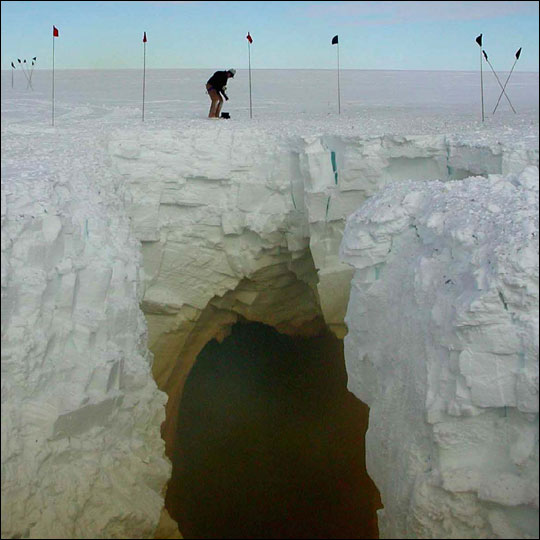

 | |||
On December 9, 2004, Robert Bindschadler, a glaciologist at NASA’s Goddard Space Flight Center, got a phone call from a colleague in New Zealand. A team of technicians was trying to complete an overland traverse across the frigid vastness of Antarctica, from McMurdo Station near the coast to the South Pole. And the team had run into some trouble. Bindschadler, a veteran of Antarctic research, knew all about the trouble the team faced: crevasses. Antarctica’s ice moves slowly, but it always moves. As a result, it often splits apart to form crevasses—cracks in the ice that can be tens of meters deep, tens of meters across, and many kilometers long. If every one were a visible, gaping hole, crevasses might merely be annoying, but when they hide beneath the snow, these cracks in the ice become deadly dangerous. |
(Image in title graphic courtesy Ted Scambos, National Snow and Ice Data Center) | ||
 | |||
“Snow blows around in Antarctica a lot,” Bindschadler explains. “It builds these snow bridges, so as a crevasse opens up, the snow sort of stretches across the top of it. It can be a few meters thick, or it can be centimeters thick.” A lightweight skier might be able to cross a thick snow bridge safely by distributing his or her weight over a wide area, but heavy vehicles don’t stand a chance. “So that’s the danger: that you walk right on top of a snow bridge and you just break through and you fall.” In their approach to the Transantarctic Mountains, the Antarctic traverse team members had run into an area filled with crevasses they hadn’t anticipated, as many as 10 in a single mile. They called George Blaisdell, operations manager for the U.S. Antarctic Program, who then called Bindschadler. Blaisdell posed a simple question: Can you help the team find a way out? |
A sinister Antarctic crevasse lurks under a snow bridge. Nicknamed Mongo, this crevasse was 32 feet (9.8 meters) wide and 82 feet (25 meters) deep. Though thick enough to support a person, the snow bridge could not support a heavy vehicle. The traverse team had to fill the crevasse with snow so that heavy vehicles could cross it safely. (Photo courtesy Russ Alger, Cold Regions Research and Environmental Laboratory, National Science Foundation) | ||